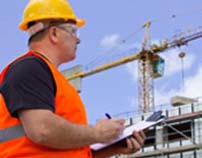
Look Up & Look Out
When you’re working outdoors, remember to look up and look out for power lines. Any contact with a power line can seriously hurt you, or even kill you.
Downed Power Line? Call 911
Always consider power lines “live” or energized. Only trained electrical workers can determine when it’s safe to be around power lines and wires. Never touch or even approach a power line.
Tips: Working Safely Around Electricity
At your daily briefing, review these tips for staying safe around electricity on the job.
- Point out nearby power lines
- Remember that overhead lines are energized and potentially dangerous, including service drops that run from utility poles to buildings
- Keep everyone and everything far away from overhead power lines
- Mark boundaries to keep everyone and everything safely away from overhead power lines
- Select a spotter to help you stay clear of power lines and other safety hazards
Keep everyone and everything far away from overhead power lines. This includes people, machinery, equipment, and any materials you use, like scaffolding tools, boat masts, fruit-picking poles, antennas, satellite dishes, pool skimmer handles, and metal ladders.
Your first step is to call 911 and inform the operator that it’s an electrical emergency. Don’t touch anything or anybody that’s been in contact with energized equipment, and keep others away too. If the person is free from the electricity source and not touching it at all, administer first aid including CPR if needed. Be sure medical help is sought immediately, even though electrical burns may not be visible.
Free DVD on Electrical Safety:
Our free, award-winning safety-awareness Video was designed for use in classroom settings, safety meetings, and individual instruction. It was produced in cooperation with law enforcement and fire agencies and we provide it at no cost to law enforcement, fire agencies, and emergency-medical teams serving our region.
To order the DVD, contact us.
Free Presentation Materials on Electrical Safety:
Being aware of the hazards and risks present in emergencies where utility lines are involved is critical for first responders. Request a set of first responder free electrical safety presentation materials.
Find safety tips in our free materials on working near power lines. Find safety tips and guides for working near power lines. Order free bilingual safety materials.
Find useful tips in the Tips of the Trade newsletter, which shares electrical safety tips to help workers stay safe on the job site.
- When You Use Trenchless Technology (PDF)
- 4 Steps for Safe Demolition (PDF)
- Safely Exposing Buried Lines (PDF)
Get more safety tips in our free materials on working near power lines.
Find safety tips in our free materials on working near power lines. These guides are endorsed by the Utility Arborists Association. Order free bilingual safety materials.
Balloonists, beware! If your balloon comes in contact with a power line, call 911 immediately, and stay in the gondola until a utility worker informs you that it’s safe to exit.
These tips are designed to help you fill, launch, and land your balloon safely.
- Walk the area before set-up and inflation, identifying power lines
- Remember that power lines may be visually hidden by trees or buildings
- When it’s dark, use a high-powered portable light to help you look for power lines
- Never inflate your balloon near power lines
- Remind your chase and ground crews to watch for power lines while the balloon is traveling and during scouting
- Balloons drift, so never land near – or upwind from – power lines
